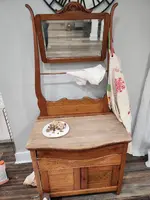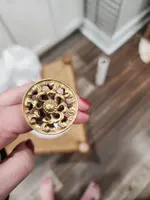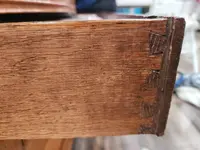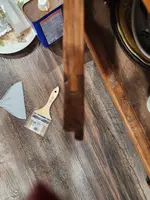You are using an out of date browser. It may not display this or other websites correctly.
You should upgrade or use an alternative browser.
You should upgrade or use an alternative browser.
🔎 UNIDENTIFIED Washstand Dating
- Thread starter Julie4austin
- Start date
Almy
Bronze Member
- Joined
- Mar 18, 2011
- Messages
- 1,619
- Reaction score
- 3,057
- Golden Thread
- 0
- Location
- Maritime Provinces
- Detector(s) used
- Tesoro Cibola
- Primary Interest:
- Other
Unless someone can match the style with a known piece, it likely is difficult to date. From what I see, it looks like a well-made small shop piece rather than made in a big furniture factory. Many of the visible wood pieces are ring-porous hardwood (note the obvious annual rings) likely ash. That's a somewhat unusual species from which to make fine furniture, and may provide a clue as to origin. If you have the drawer pulls, they might be a clue. The type of drawer side-to -front joint (finger joint or butt joint) would be useful information too. I assume you have investigated all the underside surfaces for labels and writing and found none. Interesting piece.
Upvote
2
Julie4austin
Tenderfoot
- #3
Thread Owner
Unless someone can match the style with a known piece, it likely is difficult to date. From what I see, it looks like a well-made small shop piece rather than made in a big furniture factory. Many of the visible wood pieces are ring-porous hardwood (note the obvious annual rings) likely ash. That's a somewhat unusual species from which to make fine furniture, and may provide a clue as to origin. If you have the drawer pulls, they might be a clue. The type of drawer side-to -front joint (finger joint or butt joint) would be useful information too. I assume you have investigated all the underside surfaces for labels and writing and found none. Interesting piece.
Attachments
Upvote
0
Julie4austin
Tenderfoot
- #4
Thread Owner
These are a few close up pictures of the pulls and the joints
Upvote
0
Most wash stands are mid/late Victorian. Oak was a common wood, not so much Ash though.Unless someone can match the style with a known piece, it likely is difficult to date. From what I see, it looks like a well-made small shop piece rather than made in a big furniture factory. Many of the visible wood pieces are ring-porous hardwood (note the obvious annual rings) likely ash. That's a somewhat unusual species from which to make fine furniture, and may provide a clue as to origin. If you have the drawer pulls, they might be a clue. The type of drawer side-to -front joint (finger joint or butt joint) would be useful information too. I assume you have investigated all the underside surfaces for labels and writing and found none. Interesting piece.
Lot's of different grains going on with the stand.
Not uncommon with production pieces as they used every piece regardless of how the grains matched up.
Upvote
1
Similar threads
- Replies
- 1
- Views
- 179
Users who are viewing this thread
Total: 1 (members: 0, guests: 1)






